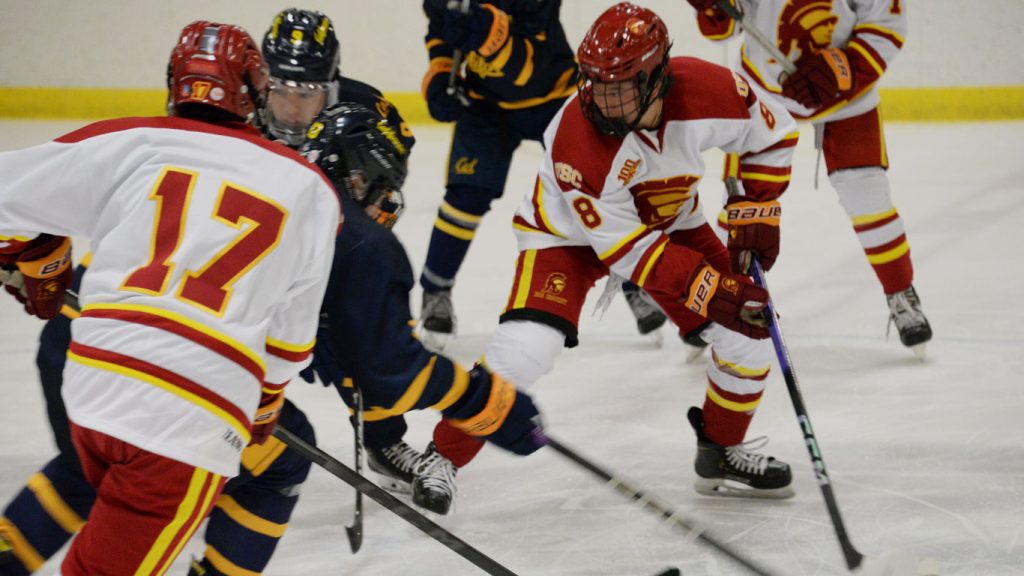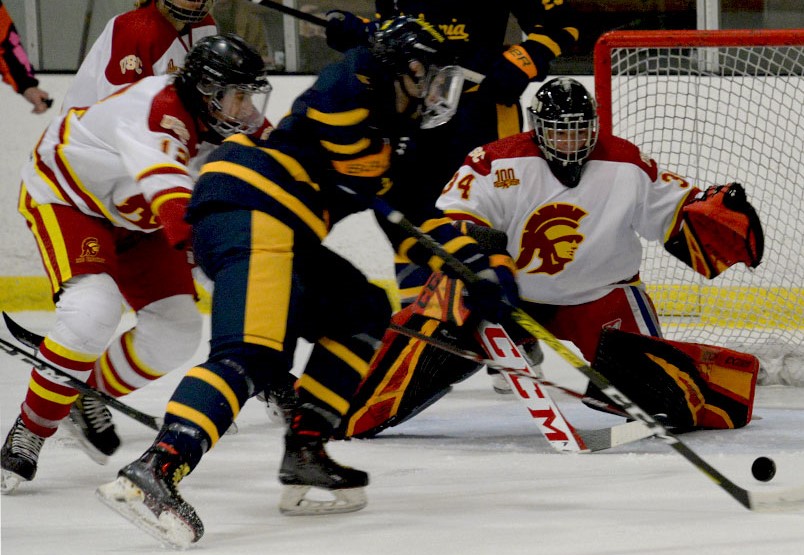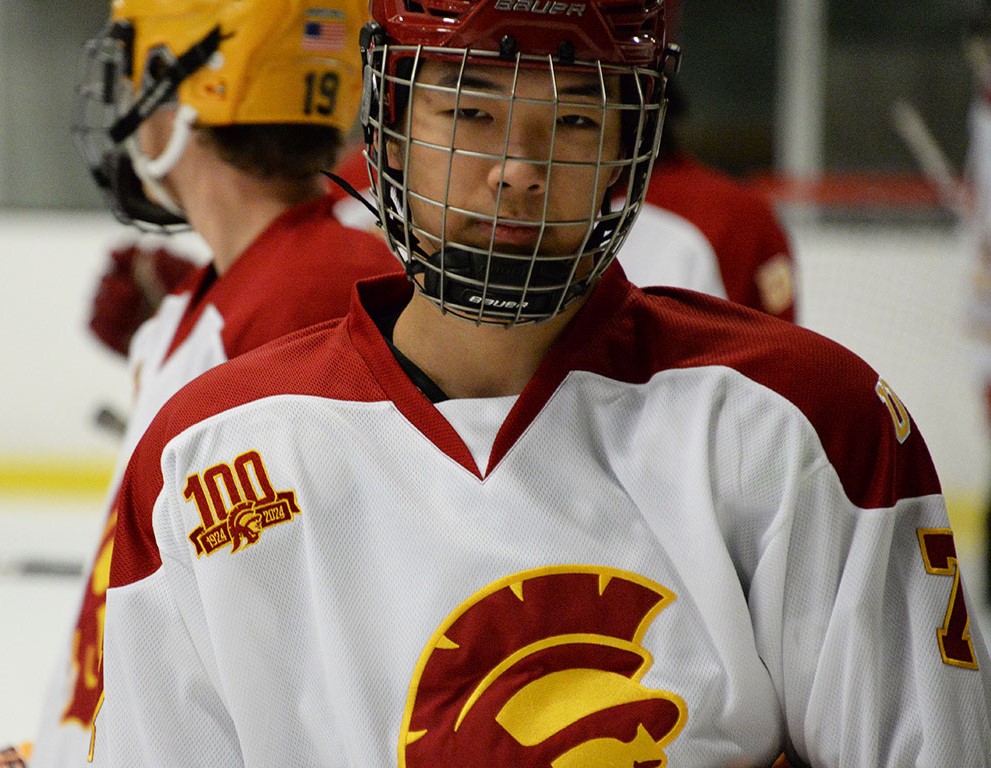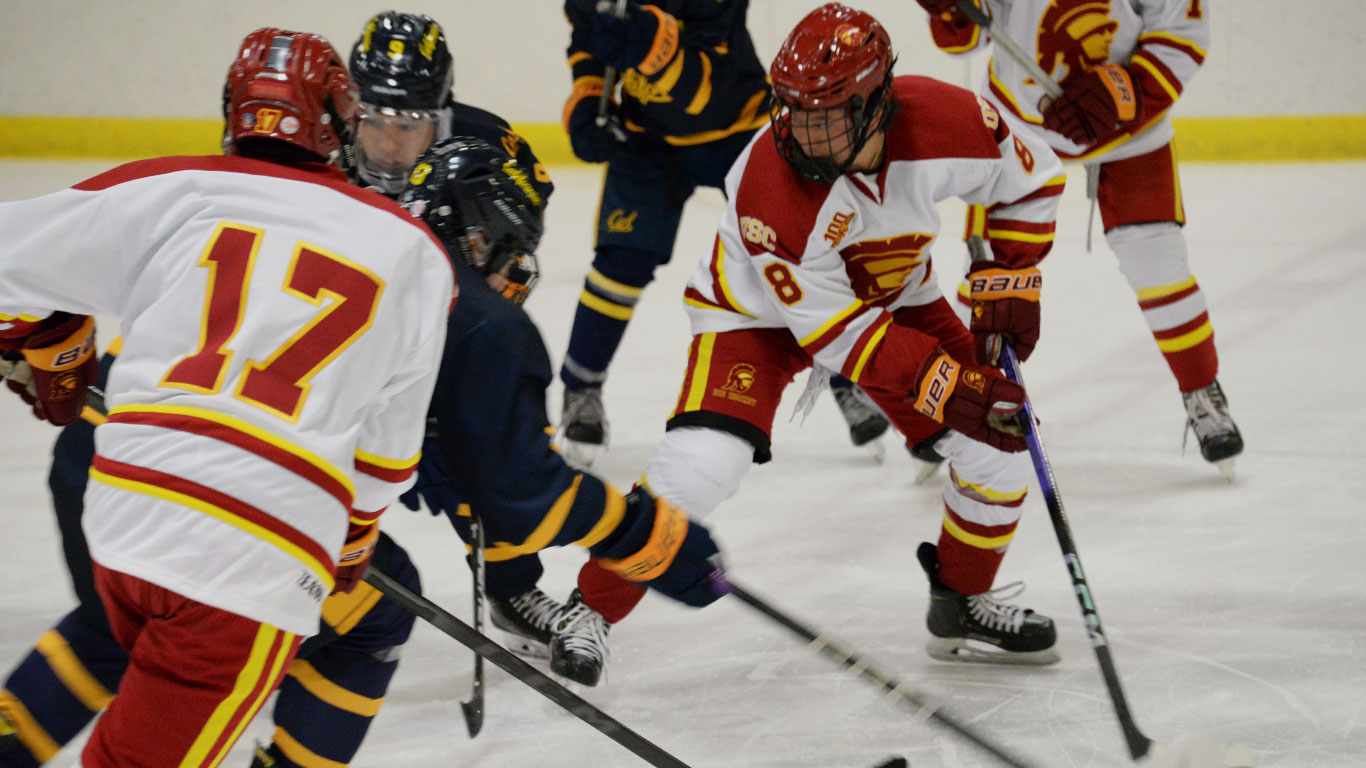
By Anthony Ciardelli/Special to USCHO.com
A college hockey team is celebrating its 100th birthday.
It’s held long and heated rivalries, won league titles, competed in national tournaments and played international opponents. You might think this is a storied NCAA Division I hockey program, but it’s not.
It’s the University of Southern California’s ACHA hockey team. Now, with 100 years under its belt, some feel the time is right to start an NCAA Division I program at USC.
100 Years
The Trojans established their club hockey team in 1924, and according to the USC yearbook, El Rodeo, mostly “novice players” rounded out the first roster. But, once the word got out that there was a hockey team at USC, “a number of former hockey players from the East and Canada turned out.” The first coach was professional hockey player Leo Cook who had played in WCHL, a major-league rival to the fledgling NHL.
The team took off in early 1929 when USC athletic director Gwynn Wilson elevated it to intercollegiate status and named Arnold Eddy the coach. It became quite the success, gaining the upper hand in newly established rivalries against Loyola Marymount University, UCLA and Cal.
Starting in 1931, the Trojans rattled off two undefeated seasons.
In 1938 and 1939 the team reached its height, sweeping two games against Big Ten champion Minnesota in California, and then again in Minnesota the next season.
1940-41 was intercollegiate hockey’s final season at USC, the war years saw the Trojans fail to field a team, but the club eventually returned during peacetime.
Its next golden era came in 1994. Mark Wilbur, a former player, took over as coach and the team had a renaissance. Wilbur – who was born in California but grew up in Minnesota, working the benches for famed Minnesota coaches Herb Brooks and Doug Woog – says he used his hockey experience and connections in the business world to negotiate sponsorships and develop alumni relationships to fund the club team on a varsity level.
We used to joke we were “Division 1/2.” Wilbur said. “We had corporate sponsors. We were on radio. We were streaming. We were like ‘Wow, the only thing these guys don’t have is hockey scholarships.’”
That included traveling internationally. According to Wilbur, USC became the first U.S. college hockey team to play in China when the Trojans played the Chinese national team in Beijing in 2002. They traveled to Iceland, Italy, France, Japan, Thailand and China again throughout the 2000s.
Under Wilbur, USC found success in league play as well. It maintained a .735-win percentage, strung together two undefeated seasons, and captured eight Pac-8 titles while qualifying for ACHA Division II nationals seven times.
Wilbur retired as USC’s coach in 2017. Now the Trojans are coached by Jerry Toy, who has had to guide USC back to its competitive legacy after the world shut down in 2020.
“The club was doing well and then COVID hit and we got shut down that next season,” Toy said. “We had one returner, so we started a new class of freshman who are now seniors. We’ve been building up and we’re in a good spot.”

Varsity Dreams
Universities from non-traditional hockey regions are starting programs. Arizona State’s hockey team is now nearly a decade old. Tennessee State University, a historically black university, is slated to begin its NCAA Division I play next season.
Still, the USC athletic department hasn’t indicated that it is, or has ever investigated starting an NCAA hockey program.
In an email, USC senior associate athletic director Cody Worsham wrote, “Our focus at this time is on our current student athletes and programs.”
Though it isn’t an outright confirmation that USC isn’t looking to start a program, it isn’t encouraging for fans hoping to someday see the Trojans take on a powerhouse like Michigan or rekindle their long-lost rivalry with Minnesota at the NCAA level.
However, now that USC varsity teams are members of the Big Ten conference, the school’s path to NCAA hockey is getting easier. Sean Hogan, executive director of College Hockey Inc, says USC should benefit from its new conference.
“Hockey is unique in the sense that we only have one multi-sport conference, the Big Ten, which USC and UCLA are now a part of,” Hogan said. “Not having many multi-sport conferences, schools that are looking to add hockey, need a home and a schedule.”
In other words, if USC wanted to start an NCAA hockey team, they don’t need to find a conference. Its schedule would already primarily be composed of Big Ten opponents.
Although things have changed in the days of NIL, USC still has an advantage that already exists for many of its other sports: recruiting.
Wilbur says that playing on an NCAA hockey program in Southern California would be a prime destination for recruits coming from the cold-weather areas where hockey thrives.
“USC would instantly be competitive in ice hockey,” he said. “It would not be a long time because kids from Finland, Sweden, Canada, the Northeast, the upper Midwest, you name it, they’d love to be in Los Angeles where it is 75 degrees in January.”
That’s before you include the increasing number of California-raised NCAA Division I hockey players who might like to stay closer to home to play their college hockey.
Varsity Costs
USC would face the same obstacle other colleges face when starting an NCAA hockey program: cost.
Hogan pointed to the first major expense.
“A facility would be No. 1 for most at the NCAA Division I level,” Hogan said. “For Division I hockey, unless you are near either a multi-use either 5,000 or 6,000-seat arena that is capable of holding ice, an ice arena on campus is usually the biggest hurdle.”
Though there are facilities that meet this description in Los Angeles, the word “near” is relative. Crypto.com arena is too big and too busy. Arenas in Long Beach and Irvine would fit the bill, but they can take more than an hour to get to from USC’s campus in LA traffic.
When USC designed the Galen Center – which hosts its basketball and volleyball teams – in the early 2000s, Wilbur, who says he participated in the planning committee, urged the school to include ice making capability.
“It was just one of those things they took out of the equation,” Wilbur said. “When they were finished with Galen, it actually ended up being too small to effectively put a hockey rink there anyway.”
There’s another cost variable involved. Schools must take Title IX into account when making the decision to add new sports.
Title IX requires equal opportunities for men and women at universities and plays a huge roll in the calculus of starting new sports programs.
Hogan says starting a women’s hockey program to mirror the men’s is not required, but leveling out the added benefit is.
“If someone wants to add Division I men’s hockey, they won’t always be adding Division I women’s hockey along with it,” Hogan said. “It will be maybe raising opportunities in another sport, but there is a little bit of a factor there.”

First Strides to NCAA Hockey
Ryan Sefidfard, who played for the team until 2009, hopes to parlay ACHA success into an NCAA program. He’s the chair of the USC Hockey Association and is attempting to follow a path that proved successful for another recently minted NCAA program.
“I really feel like there is an opportunity to do something unique here. Looking at Arizona State and what an amazing job they’ve done, they didn’t grow into that overnight,” Sefidfard said. “I look at that and think, ‘why not us?’”
That means restoring the resources that once buoyed the team back up to where they were.
“I’ve been reaching out to notable alumni of USC,” Sefidfard said. “I’ve been reaching out to some of the local NHL teams, to other successful ventures and business folks that have acquired professional teams in different sports, particularly those in the Los Angeles market. I want to share what our vision is for making USC successful at the ACHA level and hopefully get the support to help us do well in our current division and then to help us do well at the ACHA Division I level. I want to capitalize on that momentum to get significant support and, who knows, maybe do something like USC lacrosse did in building a stadium near campus.”
According to Wilbur, who prepared two detailed proposals for the athletic department in the past, the financial interest is already there.
“If USC wanted to put a Division I team in place, we could literally line up sponsors and donors to cover 30-40% of what’s needed on day one,” Wilbur said. “There’s plenty of people in Southern California that I’ve met over 19 years of coaching that are well funded and very much into USC and ice hockey.”
Toy thinks it’s also a matter of who runs the administration.
“I don’t know where [USC president] Carol Folt stands on this,” Toy said. “But now that we’re in the Big Ten, hopefully there is a change in thinking.”
Hogan also sees west coast NCAA hockey in college hockey’s future.
“I do believe with continued prying and pushing that we will see Division I hockey in the West Coast.”
